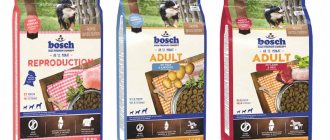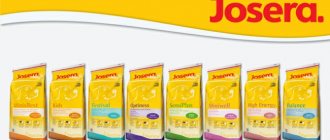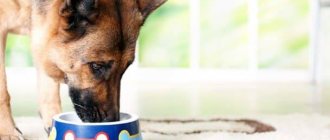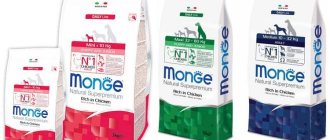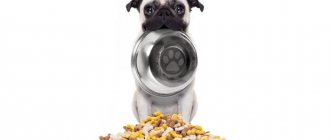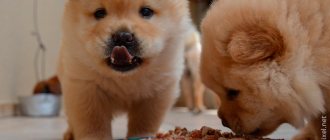Switching a dog from natural food to dry food often causes owners to worry about the health of the pet. Doubts are associated with the benefits of this product. In fact, dry food is very useful.
The main thing is to follow the instructions written on the packaging. To prevent the food from causing harm, the dog should be switched to a different diet gradually, since a sudden transition can cause complications. You should also remember that dry food does not contain enough moisture, so your pet may feel thirsty. In this article we will talk about the rules for feeding dry food, the daily water intake and answer the question of when to soak dry granules.
What is it for
Firstly, feeding commercial food can lead to crooked baby teeth in a puppy.
Secondly, in the first weeks of life, the puppy drinks only mother's milk. By the time he switches to an “adult diet,” his gastrointestinal tract is not yet fully formed, so he cannot quickly switch to solid food.
The dog's body needs time to adjust. After four months, the puppy gets used to the dry product, and there is no need for soaking.
At what age can you start feeding puppies complementary foods?
When answering the question of when you can feed puppies, veterinarians and dog experts are of the opinion that it is best to start at three weeks. Undoubtedly, mother's milk is the best food for still immature newborn puppies, but after a few weeks they are ready to get acquainted with the world around them. The ideal age to start feeding small puppies is from three weeks, or even two.
Proper diet is very important for a puppy
In this matter, it is extremely important not to rush or be late. In the first case, the mother will reduce the amount of breast milk she produces, causing the entire litter to be malnourished. In the second case, delayed complementary feeding entails a slowdown in the growth and development of the body; such pets often grow up sick and weak.
To wet or not to wet?
Many animals prefer dry kibble. With such a diet, the main thing is that there is always a bowl of water in the access area.
There is no need to soften food if:
- the dog has no problems with the oral cavity or digestion;
- appetite is normal;
- coat and skin are in good condition and look healthy;
- The dog is cheerful and active.
However, there are situations when a dog has difficulty eating dry food. In such cases, it is diluted with water.
Main reasons:
- the puppy’s age does not exceed 4 months;
- your veterinarian recommended it;
- the dog loves soaked granules and prefers them to dry ones;
- your pet has problems with the oral cavity or gastrointestinal tract.
When is this not necessary?
Some dog breeders generally give dry food in a soaked form, although their pets enjoy eating it in its original form. They are usually driven by misconceptions:
- Many dogs greedily swallow food, and owners fear that the pet may choke. But soaking the granules does not solve the problem. To slow down the process of food absorption, you can put a toy in the bowl with the food that she will not swallow. The dog will be forced to constantly push away the interfering object with its muzzle, and this will slow down its food intake.
- There is an opinion that soaked food is healthier. Another baseless version. Water does not affect its usefulness in any way.
In which cases is it not necessary to add liquid:
- The animal readily eats the food and drinks plenty of water.
- He responds well to the signal to eat and feels great afterwards.
- There were no abnormalities in the gastrointestinal tract, the coat was shiny, the skin was healthy.
- There are no difficulties with chewing and swallowing: the teeth and oral cavity are without pathological changes.
If there are no difficulties with feeding, then you should not soak dry dog food with water. An animal may eat dry food without enthusiasm, but this does not mean that it is bad or requires softening. Many flavor and odor enhancers are added to cheap diets. The pet greedily swallows such baits.
Conscientious manufacturers do not resort to such tricks and produce a high-quality product without harmful additives. Therefore, the dog eats such food with less excitement.
It is believed that softened food is easier to digest. The process occurs under the influence of hydrochloric acid and special enzymes in the stomach. It doesn't matter if the granules are dry or wet.
Water consumption rate for dogs
A dog is a predator. They require about 80% liquid from their daily diet. This is explained by the chemical composition of the meat that their relatives eat in the wild.
Dry granules contain no more than 10% moisture. It is very important to ensure that the animal has free access to drinking water. To do this, it is not necessary to mix it with food; it is enough to always have a bowl of clean liquid nearby. The dog itself will drink the required amount for normal digestion.
The volume of fluid consumed normally is calculated as follows:
- minimum: 20 mg per 1 kg of dog weight;
- maximum: 70 mg per 1 kg of weight.
It turns out that an animal weighing 20 kg needs to drink 400 – 1400 mg of liquid per day. The variation in volume depends on several factors:
- in hot weather the body requires more fluids;
- active individuals need more than passive counterparts;
- individual characteristics of the organism of individual animals.
If the pet is fed natural food, then some of the moisture enters the body along with the food. In winter, the need is significantly reduced. But if the dog is on a dry diet, it must receive additional water.
Adult dogs: to soak or not
Before answering this question, it is worth clarifying whether it is possible to constantly feed your dog only dry food.
There are two types of food: dry food and natural food. In the first case, the dog receives all its nutrients and vitamins from pelleted food. In the second, you will need to prepare it yourself, carefully selecting and weighing the products. Depending on the method of feeding, the puppy’s digestive system is formed, so using both types of food together is not recommended. The owner decides which method to choose, but a consultation with a veterinarian will not be superfluous.
A ready-made diet has a number of advantages:
- Save time. There is no need to spend it searching for and preparing food that is healthy for your dog.
- Quality assurance. The granules contain a balance of all the nutrients and vitamins necessary for the proper development and functioning of the dog’s body.
- The key to health. With dry food, the dog receives the entire vitamin and mineral complex, which would have to be purchased additionally in the case of natural feeding.
- Material benefit. Even premium food will cost less than its alternative - high-quality products.
- Convenience. Crackers can easily be taken on the road if you are traveling, or even for a picnic in the park.
It is important to remember that on such a diet you need to drink a lot of water.
Useful fact:
Dog weight x 20 mg = minimum amount of water per day Dog weight x 70 mg = maximum amount of water per day
Based on this formula, a pet that weighs 10 kg should drink from 200 to 700 ml. This is influenced by temperature, activity, as well as the individual characteristics of his body.
So, in hot weather, you should try to give your dog more water so that natural heat exchange is not disrupted.
Despite all the above advantages, there are situations in which food needs to be soaked:
- the dog has injuries to the mouth, teeth or throat;
- on the advice of a veterinarian;
- if she refuses to eat dry kibble but likes it in a box.
Some dogs don't drink enough water with their meals, which can cause digestive problems. Soaked granules in this case will help solve them.
How to soak dry food
Properly soaking dry puppy food is quite simple. First you need to pour the granules into a container. Fill them with slightly warmed water or low-fat broth so that the food is completely covered.
Do not dilute it with too cold liquid or boiling water. Boiling water kills some of the beneficial microelements, and in cold water the granules do not swell for a long time.
Wait until the moisture is completely absorbed. This takes no more than a few minutes. You can grind the food that has swollen in water with a blender or fork until it turns into baby puree. Instead of water and broth, you can use low-fat milk or kefir.
Please note that dry puppy food should not be soaked. You just need to soak it a little.
Soaking is a long process. If dry dog food is soaked for a long time, its beneficial properties are destroyed.
Cooking recommendations
Pour enough water into a plate of dry food so that it completely covers the entire contents. After this, you need to give it time to brew and swell. Next, the food can be served to the dog. When such food is served for the first time, the dog will first sniff it (soaked food does not have as strong a smell as dry food), and then, having tasted it, will begin to eat with great pleasure.
When soaking, pay special attention to the temperature of the water. According to the advice of veterinarians, it should not exceed 35 degrees. In this case, the beneficial substances will not be destroyed, although such preparation will take longer than soaking with boiling water.
Thus, the benefits of feeding dogs food in a soaked form are quite obvious. By following all the recommendations, you can provide your pet with a healthy and nutritious diet.
Prohibitions and recommendations
In order not to harm the puppy’s growing body, you must follow several recommendations.
- When starting to introduce dog food into your diet, at first you should use only water for soaking. After 1-2 months, you can try to soften the food in low-fat broth and milk, but if the baby experiences indigestion, then it is better to abandon this idea.
- You can use only warm water, the temperature of which does not exceed 40 degrees. When dry granules are steamed in boiling water, some beneficial substances are simply destroyed, therefore, the food will be less healthy and nutritious.
- After feeding the puppy, leftover food should be put in the refrigerator, but it can be stored for no more than 12 hours. Before the next feeding, the food needs to be warmed up a little. It should be noted that such manipulations can only be carried out with food soaked in water, and in other cases the remains must be thrown away.
- To steam the food, you must use purified water, and it is also important to remember to wash the bowl before and after preparing food.
Dog owners should remember that water should always be freely available to their pet, as a lack of fluid may disrupt the pet’s digestive process.
For information on how to properly soak food, see below.
Can dry food for adult dogs be soaked in water? Softening the granules with ordinary water does not affect their beneficial properties and nutritional value. But most animals consume it with pleasure in its pure form.
Some dog breeders believe that dry food granules can scratch the delicate surface of the pet's stomach mucosa. Whether this is true or a myth, in which cases wetting can be used and with what, we will examine in detail in this article.
Tips for small breed dog owners
Each breed has specific feeding recommendations. Most small breed dogs are predisposed to oral diseases such as caries, stomatitis, gingivitis, periodontal disease, and enamel dysplasia.
Among the breeds at risk are small poodles, spaniels, lap dogs, dachshunds, Pekingese, Yorkshire terriers and others.
The nutrition of such puppies must be approached with extreme caution. Starting from one month of age, the dog is gradually introduced to dry food diluted in water in a ratio of 3:1. After two and a half months, you can switch to a regular diet.
It is important to select high-quality dry food of at least premium class. The following brands are recommended for owners of these breeds: Royal Canin, Orijen, Akana, Bozita, Monge and Brit Kare.
Chihuahuas have an increased tendency to allergies and digestive disorders. For lovers of this breed, it is better to choose super premium food. Breeders recommend Total, Bosch, Proplan. Guts.
As a rule, small breed dogs do not like dry food, so the food should be softened in warm water. Thanks to this, the food will be digested faster and the dog will not feel discomfort.
How to wean puppies off their mother's milk
Small breed food for puppies as well as large and medium breeds
Weaning puppies from their mother is recommended from 6 weeks of age. Typically the deadline is 8 weeks. You can calmly separate puppies from their mother only if they are already consuming the daily amount of food on their own. These are the dates they focus on when deciding when to start feeding puppies correctly.
The peculiarity of weaning is this: for the first two or three days, the pets are left with the usual amount of food, after which they begin to gradually increase it to the required levels.
Assortment of food for puppy's first feeding (starters)
Important! Rapid weaning of the litter from a bitch while simultaneously reducing the amount of food she consumes leads to a reduction in milk production and also serves as a preventive measure for the development of mammary gland diseases.
First feeding
If the puppy's baby teeth have begun to appear, the owner can gradually introduce complementary foods. Although the mother will continue to feed the puppy until approximately 1.5 - 2 months, it can be introduced to a new diet from the age of three weeks.
You need to crush the granules and soak the dry puppy food with warm milk. After about a quarter of an hour, everything is ready.
The frequency of feeding is selected individually, depending on the characteristics of the dog. After three months, you should exclude milk from the diet and moisten the granules with water or meat broth.
Veterinarians do not recommend mixing “drying” with natural products. This can cause gastrointestinal upset. Good quality food contains enough essential microelements. The packaging usually indicates the daily ration requirements, taking into account the age and weight of the dog.
Posts 1 page 20 of 56
Share01/123/2013 08:29:13
- Author: Orange
- Beagle
- From: Moscow, Central Administrative District
- Registered: 11/19/2012
- Posts: 704
- Female gender
- Age: 32 [1989-02-28]
- Last visit: 03.12.2014 19:55:24
The puppy is 8 weeks old, adopted at 7, for the first 4 days he was fed mixed (natural + Pro Plan for puppies), exactly the same as he was fed before us. Then they gradually switched to dry food only - he eats with pleasure, his stool is normal, he also feels very good))
This is, in fact, the question: until what age should the food be soaked? The package says up to 3 months. But a soaked dog doesn’t eat well, now I fill it with warm water for literally 2-5 minutes (the pieces themselves are small) and he eats it with some water. She always has enough fresh water, she drinks whenever she wants. Will unsoaked food damage the stomach?
Edited by Orange (01/23/2013 08:29:50)
Share01/223/2013 08:51:21
- Author: Vita+Linda
- Top-beagle
- From: Moscow
- Registered: 02/17/2010
- Posts: 12515
- Last visit: 10/16/2020 21:14:07
It won't hurt. If you like it, eat it with pleasure, if there are no problems with stool, then you can. I have already given puppies at this age dry food without soaking it, they really like to chew on something hard much more.
Edited by Vita+Linda (01/23/2013 08:59:14)
Share323.01.2013 09:41:34
- Author: Yuli Rainbrook Park
- Beagle
- From: Israel
- Registered: 07/05/2010
- Posts: 654
- Female gender
- Age: 51 [1970-08-17]
- Last visit: 04/29/2017 09:05:23
The club recommends that at the time of delivery of puppies (8 weeks) we completely switch them to dry food. That’s what we do, it’s more convenient for us, the puppies, and future owners.
Share423.01.2013 09:49:55
- Author: Orange
- Beagle
- From: Moscow, Central Administrative District
- Registered: 11/19/2012
- Posts: 704
- Female gender
- Age: 32 [1989-02-28]
- Last visit: 03.12.2014 19:55:24
What and how to give puppies after one month of age
The schedule and mode of feeding your pet directly depends on its age. At different stages of growth and development, a dog’s body needs certain substances. This must be taken into account when planning your diet.
During the period of 1-2 months, the puppy experiences an acute need for calcium. This macronutrient is necessary for the body for proper skeletal development. That is why the daily diet should consist of approximately 40-50% dairy products. You can introduce kefir, sour cream or cottage cheese into your diet.
Note! It is better not to give fruit yoghurts and other dairy products that contain dyes and flavor enhancers.
In addition to dairy products, your pet also needs fresh meat. Per day, as a percentage, it should be at least 40%. It is recommended to give preference to boiled poultry or raw beef. You should definitely give up fatty pork. The remaining 10-20% consists of fresh vegetables and fruits.
What to feed your dog?
Animals need a variety of foods to eat healthy. An important one is meat, but the diet should consist of 2/3 of it. And the rest is occupied by products of plant origin. Bones are considered essential for a dog. They are rich in lime, protein, collagen and other components necessary for the growth and development of the animal. Moreover, “gnawing” improves the condition of teeth and gums.
Dogs should not be given sweets, as this causes obesity and other diseases. Potatoes and legumes are difficult for the dog’s body to digest. You don't need to give them corn either. For convenience, many owners buy dry food that can be stored for a long time.
How long can softened food be stored?
It is advisable that the puppy eats everything that is prepared for him at one time. This especially applies to the hot season, since food softened in broth or kefir will quickly deteriorate and pathogenic bacteria may develop in it, which will lead to poisoning of the pet. When soaked food is stored in the refrigerator, its taste properties are lost.
Pay attention to the dog's behavior. If she eats dry food with appetite and washes it down with water, then there is no need to soak the granules.
Without special reasons, you should not accustom your pet to soaked food, as this can become addictive, and the dog will subsequently forget how to chew solid food in its natural form.
How long does food prepared this way last?
Manufacturers do not provide such an option for feeding their feed, so they do not indicate the shelf life for it in wet form. If the dry product can be poured in and left for a long time, then the moistened dog should eat it at one time.
You cannot prepare such food for future use. If the portion is not eaten, then it is better to get rid of the leftovers. In hot weather, wet food spoils quickly. Moreover, if you use other substances rather than pure water.
Eating spoiled food leads to intestinal upset and poisoning. You can put leftovers in the refrigerator for no more than 12 hours. Before serving, you should warm it up a little, but the consistency and taste of the product will differ from freshly prepared. Don't be surprised if your pet refuses it.
If you like the benefits of feeding a dry diet, experts do not recommend introducing your animal to soaked food. Otherwise there must be good reasons for this. Having decided to pamper your pet once, you may later face refusal of dry granules. Do not prevent your pet from enjoying crunchy “crackers” if he drinks them with a sufficient amount of water.
Many dog owners feed their pets soaked food. This type of nutrition is practiced not only when raising puppies, but also for adult animals. But not everyone approves of this method of providing food. Is it possible to soak dry dog food?
Price and quality
When your pet becomes an adult, it will be possible to switch to cheaper food. But it is recommended to do this only if absolutely necessary. For puppies, feeding economy class dry food is completely unacceptable. To ensure that an adult dog does not have health problems, you need to invest as much as possible in the baby. Therefore, choose only super-premium brands, and even better, professional food. Consult your veterinarian and breeder, he will tell you which one is best to buy.
Reviews
Elena, Smolensk
“I believe that food should be diluted only as long as the puppy has milk teeth. We ate natural food for up to six months, then switched to dry food. Initially, I soaked the food until it was mushy, then I started feeding the dog semi-soaked food. A week later we switched completely to dry. At first, our Bim didn’t understand how to eat it. Now she eats dry food with pleasure!”
Inna, Tula
“My Chappie turned 9 months old yesterday. We bought the puppy very young, he was only 1.5 months old. We immediately decided to feed him dry food. Fill with water for 15-20 minutes. At the command “Eat,” the bowl is licked within a minute. I've heard that puppies can't control their water intake on their own. Thanks to this method, I know for sure that my pet consumes enough water.”
Is it necessary to soak the food?
Despite manufacturers' recommendations, breeders claim that dry puppy food needs to be soaked, and there are several reasons for this:
- hard granules can damage the baby’s delicate gums;
- baby teeth are not strong enough to chew such hard food;
- the stomach of a small pet does not have the necessary enzymes to digest dry granules, which can cause disruption of the gastrointestinal tract;
- Consumption of dry food during the teething stage can lead to crooked teeth.
There is an opinion among dog owners that chewing dry food helps strengthen and clean teeth, but this is a misconception. To remove plaque, it is necessary to resort to regular brushing of the teeth with a brush, and to strengthen it, it is recommended to give the puppy special toys. It should also be taken into account that as a result of damage to the gums by hard granules, the baby will experience discomfort at every meal, which is why he will not be able to eat the prescribed portion or will refuse to eat at all.
Soaked food can be given to puppies over 1 month of age. This can be either a separate dish or an addition to soup, porridge and other food. It is recommended to feed dogs soaked kibble until their baby teeth come in. For each breed, this period lasts differently, usually lasting no more than six months. Therefore, at the 7th month of life, you can add dry granules to your pet’s food, but their amount should not exceed 25% of the serving.
Gradually, the ratio of solid and soaked food increases; at about the age of 1 year, the dog will be completely switched to dry food.
After three months
From this age, milk is completely excluded from the diet, as it now causes digestive problems. By about 4-5 months, babies switch to four meals a day, but not all owners refuse to soak. Some people add water, others prefer kefir. What do veterinarians say about this? There are no clear answers either. Some experts are categorically against this, while others believe that this reduces the load on the gastric mucosa.
Is it possible to resort to soaking?
If we talk about whether dry cat food can be soaked, it all depends on the specific situation. Veterinarians often comment on this issue.
Often, older cats pounce on food and begin to swallow it very quickly, without even chewing. This happens when an animal begins to have problems with its teeth or its fangs completely fall out. In this case, it is also worth either switching your pet to a more liquid diet, or figuring out whether dry cat food can be soaked.
You need to understand that in the absence of the required amount of liquid, dry components can stagnate in the animal’s body, and this, in turn, will lead to constipation. It is not recommended to allow this, since in this case intoxication will begin and poisons will begin to be released into the gastric tract. It's better to add some water to your food.
Soaking rules for adult animals
Can dry dog food be soaked in water? Yes, but this procedure must be performed correctly so that the nutritional value is retained in the finished product:
- You need to pour a little water into the bowl so that it covers the food. Wait until it swells. Then the food can be offered to your pet. At first, dogs can only smell the food, but after trying it they eat it with pleasure.
- It is necessary to select the appropriate water temperature. Veterinarians advise using liquid up to 35 degrees. The swelling will last longer, but the food will retain its valuable properties.
- To make your dog eat the food more willingly, you need to warm it up a little.
Can dry dog food be soaked in milk? Pets love this vitamin combination very much. It is enough to just heat the product a little.
Vitamins
A
Fat-soluble vitamins of group A, good sources of which are sunflower and butter, egg yolks; liver and kidneys (in particular, marine life). The vitamin regenerates cell membranes, restores and improves the quality of vision, and has a beneficial effect on the growth of bone and joint tissue. The dose of vitamin A should not exceed 1000 IU per day. Carrots, green onions, peaches, apricots and similar plant products contain beta-carotene, which is provitamin A (this means that when ingested, these substances are converted into vitamin A).
D
The volume of vitamins D synthesized in the epithelial layer of the skin under the influence of UV rays actively participates in the circulation of calcium in the body, as a rule, does not exceed 300 IU. Vitamin D is found in optimal amounts in liver and fatty fish. There are several forms of vitamin (D2 and D3). The vitamin is a specific remedy against deficiency of bone and cartilage tissue, problems with the cardiovascular system.
E
Acts as a resource for the synthesis of connective tissue. The shells of new cells are built from it, and old ones are restored. It also regulates the functioning of the sebaceous glands, muscle contractions and the functioning of the musculoskeletal system. The source of the vitamin is the lungs and skin (especially chicken).
TO
The best anti-allergen or coagulating agent, ensures normal blood clotting. When it is deficient or insufficient in the body, inflammatory processes progress or internal bleeding may even occur. Vitamin K is found in plant foods, especially spinach, all types of cabbage, and bird bone marrow. This vitamin is food for bacteria that inhabit the intestines.
An excess of fat-soluble vitamins has negative consequences for the body, as does their deficiency. The body does not remove them in full, as a result of which they accumulate in the liver and adrenal glands. Such reserves can cause toxicosis or poisoning if the body does not need them. This happens most often with groups A and B.
IMPORTANT ! If your dog is active and leads a mobile lifestyle, his need for nutrients will be much higher than that of a passive pet. This is due to the fact that every day the muscle tissue is under load, which means it receives microtraumas that require resources for recovery.
The use of fat-soluble vitamins, for example, vitamins A and D, especially in large dosages, can only be done with the approval of a veterinarian. With prolonged use, liver dysfunction, chronic fatigue, headaches, swelling of the limbs, hair loss, and bone pain are possible.
The formation of cholelithiasis and acute inflammatory process in the pancreas is possible. A large amount of vitamin D causes an increase in the concentration of calcium in the blood, loss of appetite, nausea and vomiting, fever, loss of strength and apathy, sleep problems, and kidney stones. An excess of vitamin E in the body causes diarrhea, fatigue and headaches.
Water-soluble vitamins cause less harm, because the bulk of them, which the body does not use, is excreted in the urine.
WITH
Another name is ascorbic acid, which plays a critical role in the functioning of the immune system and the synthesis of collagen and elastin. This substance is also the starting material for the synthesis of hormones, including serotonin, which is responsible for a good mood. If your pet suddenly becomes sad and quiet, this is most likely what he is missing. In addition, it is involved in tissue regeneration and helps absorb all other vitamins.
B vitamins
Participate in the regulation of heat exchange processes, controls the functions of the sebaceous glands and maintains the healthy condition of the coat. It also produces an enzyme that coats every hair on the body, repelling parasites and insects that can multiply and cause skin diseases (lichen, lice, mites).
It is very important to use vitamins only as prescribed by your veterinarian . If possible, get vitamins from food, since the tablet form is not always easily absorbed by the body. If you are allergic to certain foods, store-bought vitamins are the only way out of the situation.
Diet depending on age
1 month
What is the best way to treat a one-month-old baby? At the initial stage, the puppy's gastrointestinal tract is adapted to digest only mother's milk and some soft food. It is better not to overload the baby’s body and give him cow’s milk , if it is not possible to eat mother’s milk, milk with cream and porridge (buckwheat or oatmeal).
Never give puppies hard beef bones : they may not be digested and may end up in the intestines and scratch or even tear them.
Also, it depends on the breed. There are dogs that genetically have a low appetite (dachshunds, spaniels), so there is no need to worry if the puppy does not eat anything - he simply does not want to.
2
At 2 months, the puppy’s eyes are already appearing and teeth are beginning to form. It is recommended to give a two-month-old animal a small amount of cottage cheese, feta cheese, or hard cheeses, boiled vegetables, cabbage, and fresh minced meat .
3
A three-month-old puppy has already formed a chewing reflex, which means it can be fed with solid meat . At 3 months, it is better to give meat raw, since the body is accustomed to this type of protein.
If you give boiled meat, the puppy will eat it, but problems may arise with absorption, since the meat is partially digested, and the amount of enzymes and gastric juice will be released as if it were raw. This may lead to irritation of the stomach walls or even a gag reflex.
4
By 4 months it’s time to sharpen your teeth. You can feed your pet bones , first breaking large pieces in half so that they do not become across the throat.
You can give chicken feet, but you need to cut off their claws to eliminate the chance of injury to the esophagus.
Some pet stores sell mineral bones , these are also available.
5
At 5 months, the dog can already digest large portions of food; sometimes you can even pamper him with fried meat (in moderation).
Remember that a dog is a predator. Every dog needs to compete and receive rewards, so reward your dog with his favorite treats for good deeds or obedient behavior. You can also use treats to train your pet and teach it commands.
From 6 months to a year
You can include porridge, bread, potatoes (even raw) . It will provide your pet with energy and ease the gastrointestinal tract, thanks to its fiber and microelements content. You can add porridge as the bulk of the dish, some seasonings, and a little salt to improve the taste.
Dogs have very individual tastes. Try to understand what exactly your ward likes. Some dogs like very unexpected foods: for example, pork spleen, lamb heart, tripe. There are also those who eat sauerkraut (although eating salty foods is not recommended for animals) or boiled potatoes.
Chicken eggs are a favorite treat for dogs. They are rich in healthy polyunsaturated fats and protein, which is the standard for all living organisms, since it contains a complete amino acid profile and is absorbed almost instantly. The maximum amount that will not harm your pet is 3-4 whole eggs per week .
conclusions
General tips:
- limit your consumption of fried and fatty foods;
- Give sweets as a reward or dessert only on rare occasions;
- follow a timed diet;
- do not overload your pet’s gastrointestinal tract before bedtime;
- plan a diet that is complete and varied;
- remember: dogs love raw meat.
Remember that every pet is different, and there is no one general standard for all dogs . Listen carefully to the well-being and behavior of your four-legged friend, because he cannot speak, which means you have double responsibility.
If necessary, consult a doctor, because this is a person with many years of experience behind him who can easily and quickly determine and eliminate the cause of the disease. Self-treatment or therapy with medications (including vitamins) can lead to serious irreversible consequences.
Share your opinion in the comments . How often do you feed your pet? Do you prefer natural food, or have you opted for store-bought food? How many of us give our dogs vitamins? How often do you visit the veterinarian? Share photos of your pets. Your problem may have already been solved by a member of our community.
Shelf life of soaked feed
If you can simply pour dry food into a bowl and leave it - the dog will eat it when he is hungry, then how long can soaked dry food be stored?
Experts do not recommend storing it soaked for too long. (No one can answer you what is too much in this case and what is not. After all, as we said above, the food manufacturer does not involve such manipulations with its products.) Therefore, prepare such a portion at a time that the pet can eat it right away. The remainder will need to be thrown away. Since, especially in hot weather, they can quickly deteriorate and cause stomach upset and poisoning in your four-legged friend.
It is also not recommended to store soaked food in the refrigerator, since the trapped moisture will gradually destroy its structure, and your pet will ultimately be unlikely to want to eat the “porridge.”
Feeding regimen: how many times a day do you need?
Let us again remember evolutionary factors. Dog and wolf packs have always wandered from place to place in search of food or to find shelter. They did not have time for large meals and long rests between them, since they were always on the move. The average number was 4-5 meals per day with a break of 2-3 hours.
- From one and a half to two months, it is recommended to feed the puppy 5 to 7 times a day with breaks of 2-3 hours.
- In the third month, the portion is increased, and the number of meals is reduced to 4 times a day .
- By six months the number of feedings reaches 3-4 times .
- By 1 year of life - 3 .
- A dog from 1 year old should eat in the morning and evening, at certain hours set by the owner.
For comparison, cats can eat once a day, and rest the rest of the time to rest and recuperate.
By the way, remember that frequent walks, active behavior, and growth rate also affect appetite and the amount of food needed.
Features of feeding kittens
If a kitten aged 6 to 12 months lives in the house, then he should be given no more than 100 grams of dry food per day. Older pets require 2 times more. As a rule, food packages indicate the approximate volume and how many times the animal should be fed.
It is also worth considering that animals do not always understand exactly how many nutrients they need to fully function. Fluffy fidgets love to climb into the refrigerator or on the table at night and feast on what people have left. At the same time, you should carefully monitor the animal and try not to spoil it. If you give him what people eat, it will not help the development of his digestive system.
When a cat looks much larger than its fellows or suffers from obesity, then it should be fed no more than 2 times a day, no matter how much it asks for more.
If there are more than two pets living in an apartment, then you need to allocate a bowl for each of them and make sure that both pets receive the required amount of food.

